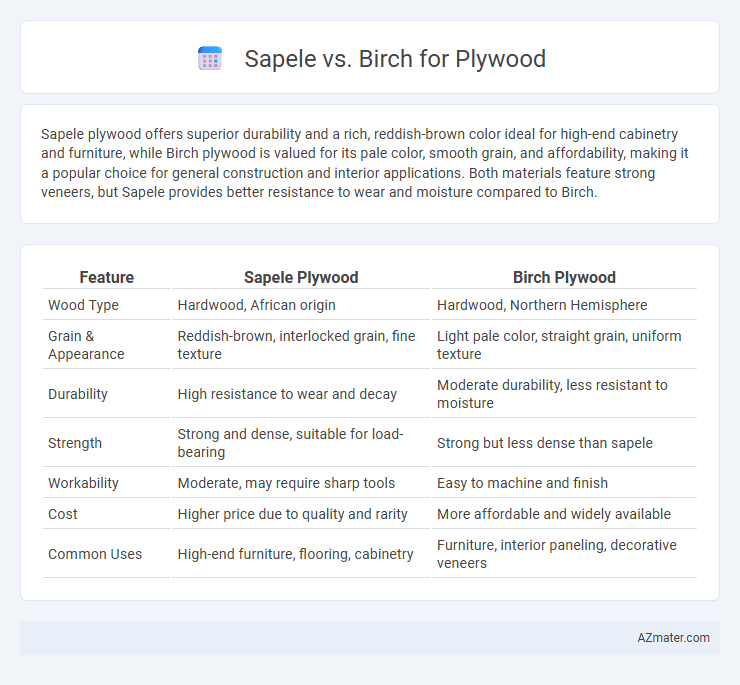Sapele plywood offers superior durability and a rich, reddish-brown color ideal for high-end cabinetry and furniture, while Birch plywood is valued for its pale color, smooth grain, and affordability, making it a popular choice for general construction and interior applications. Both materials feature strong veneers, but Sapele provides better resistance to wear and moisture compared to Birch.
Table of Comparison
| Feature | Sapele Plywood | Birch Plywood |
|---|---|---|
| Wood Type | Hardwood, African origin | Hardwood, Northern Hemisphere |
| Grain & Appearance | Reddish-brown, interlocked grain, fine texture | Light pale color, straight grain, uniform texture |
| Durability | High resistance to wear and decay | Moderate durability, less resistant to moisture |
| Strength | Strong and dense, suitable for load-bearing | Strong but less dense than sapele |
| Workability | Moderate, may require sharp tools | Easy to machine and finish |
| Cost | Higher price due to quality and rarity | More affordable and widely available |
| Common Uses | High-end furniture, flooring, cabinetry | Furniture, interior paneling, decorative veneers |
Introduction to Sapele and Birch Plywood
Sapele plywood is derived from the Sapele tree, known for its rich reddish-brown color and strong, durable grain, making it ideal for high-end cabinetry and furniture. Birch plywood, sourced from the Birch tree, offers a pale, smooth surface with excellent strength and stability, commonly used in interior applications and cabinetry. Both types provide exceptional workability and resistance to warping, catering to various construction and woodworking needs.
Origin and Botanical Characteristics
Sapele plywood is derived from the Sapele tree (Entandrophragma cylindricum), native to West Africa, characterized by its dense, interlocked grain and reddish-brown hue. Birch plywood originates from birch trees, primarily Betula pendula and Betula pubescens, found in the northern temperate regions of Europe and North America, noted for a fine, tight grain and pale color. Both species offer durability but differ in appearance and growth habitat, impacting their suitability for various plywood applications.
Appearance and Grain Differences
Sapele plywood features a rich reddish-brown hue with a pronounced, interlocking grain pattern that creates a striking, ribbon-like effect, offering a visually dynamic texture. Birch plywood presents a pale, creamy color with a fine, consistent grain that yields a smooth and uniform surface ideal for paint or clear finishes. The contrast between Sapele's bold, decorative grain and Birch's subtle, even texture makes each suitable for different aesthetic preferences in woodworking projects.
Hardness and Durability Comparison
Sapele plywood offers higher hardness with a Janka rating of approximately 1,410 lbf, making it more resistant to dents and wear compared to birch plywood, which has a Janka hardness near 1,260 lbf. Durability-wise, Sapele features greater natural resistance to moisture and insects, enhancing its lifespan in humid environments, while birch plywood is more susceptible to swelling and damage under prolonged exposure to water. For applications requiring a tough, long-lasting material, Sapele plywood demonstrates superior performance in both hardness and durability.
Workability and Machining Qualities
Sapele plywood offers excellent workability with a fine, even texture that machines smoothly, producing clean edges and minimal splintering. Birch plywood is highly valued for its superior machining qualities, allowing precise cuts and excellent screw holding power due to its dense, uniform grain. Both woods provide reliable surfaces for sanding and finishing, but Birch's consistent hardness often results in better performance for detailed woodworking projects.
Moisture Resistance and Stability
Sapele plywood offers superior moisture resistance compared to Birch, making it more suitable for humid or wet environments due to its higher natural oil content and dense grain structure. Birch plywood provides excellent dimensional stability and strength but is more prone to swelling and warping when exposed to moisture, requiring additional sealing treatments for outdoor or damp use. For applications demanding moisture resistance and long-term stability, Sapele plywood is generally preferred, especially in marine or exterior contexts.
Cost and Availability
Sapele plywood generally costs more than birch due to its exotic hardwood status and durability, making it a premium choice for furniture and cabinetry. Birch plywood, widely available in North America and Europe, offers a more affordable and easily accessible option with consistent quality for general construction and interior projects. The availability of birch plywood in a variety of thicknesses and grades makes it cost-effective for large-scale applications compared to the limited supply and higher price point of sapele.
Environmental Impact and Sustainability
Sapele plywood, derived from the Sapele tree native to West Africa, is often criticized due to unsustainable logging practices and habitat disruption, whereas Birch plywood from sustainably managed Northern European forests offers a more eco-friendly alternative with lower deforestation risks. Birch plywood generally boasts certifications such as FSC and PEFC, ensuring responsible forest management and reduced environmental footprint, while Sapele sources may lack consistent certification. Both materials are renewable, but Birch plywood's widespread sustainable sourcing and higher recycling potential make it preferable for environmentally conscious construction and furniture projects.
Typical Applications in Furniture and Construction
Sapele plywood is favored for high-end furniture and interior paneling due to its rich reddish-brown color and durability, making it ideal for cabinets, doors, and decorative veneers. Birch plywood is commonly used in structural applications and furniture manufacturing that requires strength and a smooth, light finish suitable for painting or laminating. Both types offer stability and resistance to warping, but Sapele excels in aesthetic appeal while Birch provides superior strength for construction needs.
Choosing the Right Plywood for Your Project
Sapele plywood offers exceptional durability and rich reddish-brown color, ideal for high-end cabinetry and furniture requiring strength and aesthetic appeal. Birch plywood provides a lighter, smoother surface with superior stability, making it well-suited for interior applications like shelving and paneling where a clean, smooth finish is essential. Selecting between Sapele and Birch depends on project demands for color, strength, and finish quality, ensuring the plywood complements both structural needs and design preferences.

Infographic: Sapele vs Birch for Plywood
 azmater.com
azmater.com